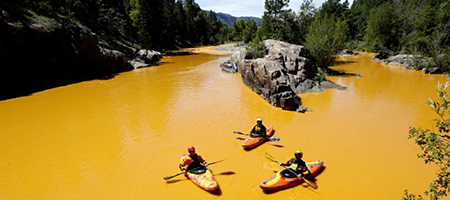The house I lived in for nearly two decades is a mile from the Kansas River, which unevenly bisects my hometown of Lawrence, Kansas. I’ve walked over the bridge and down the levee more times than I can count; I ride bikes in the trails and collect wildflowers there. It is a fundamental part of my home and my childhood.
Like most rivers in urban areas, this portion of the Kansas River isn’t clean by any stretch of the imagination—you shouldn’t eat the fish or drink the water, but it won’t turn orange from heavy metals because there are no hardrock mines around. The same cannot be said of the Animas River and its watershed. On this day in 2015, 3 million gallons of mine waste (tailings) burst from the abandoned Gold King Mine outside of Silverton, Colorado. It flowed through various rivers and tributaries in Colorado, New Mexico, Utah, and the Navajo Nation, where 15 percent of residents do not have access to clean water.
You’ve probably seen photos of the results even if you don’t know where they’re from: the one below, of a group of kayakers floating on a neon orange river, is one of the most iconic photos of modern American environmental devastation.
Like many environmental disasters, the Gold King Mine spill indicates a larger problem, in this case, the nation’s hugely outdated mining laws. In 1872, the United States had just finished the Civil War and was aggressively expanding westward. Congress passed the General Mining Law of 1872 to encourage settlement of lands, whether they had previous inhabitants or not. To incentivize settlers, this legislation created a land and mineral patenting system, which allowed any party to stake a claim to Western public lands with valuable minerals beneath the surface.
Gold King Mine operated, on and off, between 1887 and 1922 though remained dormant for nearly a century, except for more gradual acid mine drainage into the Animas. During that time, the mine passed through many owners. Yet, because of the 1872 Mining Law, none were required to post reclamation bonds—money that the mine owner gives to the government to cover clean up costs.
Many mines have multiple owners over the course of their existence due to the erratic nature of hardrock minerals markets that often bankrupt companies. Because of a law passed before women could vote or the invention of electricity, mining companies still get away with not cleaning up environmental destruction they’ve caused. In addition, hardrock mining operators don’t have to pay royalties or have to get the consent of nearby or affected communities to mine.
Mining operators, those on both sides of the millennium, owe the rivers and the communities that rely upon them. Time and time again, we see massive environmental devastation wrought by the carelessness of corporations, leaving already-disenfranchised communities to pick up the pieces, while board members and CEOs escape any real accountability.
There is a very obvious solution to many of the problems mining perpetuates: reforming the 1872 Mining Law. However, not only has the mining industry effectively stymied any interest in doing this, but now Republicans in both chambers use the bogus “critical minerals” cloak to open up federal lands to mining.
Whether through exercise or commerce or fishing or tourism or religion, rivers are crucial to all people, whether they acknowledge it or not. Valuing the Animas River means reforming the 1872 Mining Law to hold the mining industry responsible for cleaning up their own mess. On the fifth anniversary of the Gold King Mine waste water spill, lawmakers should begin this effort anew.

